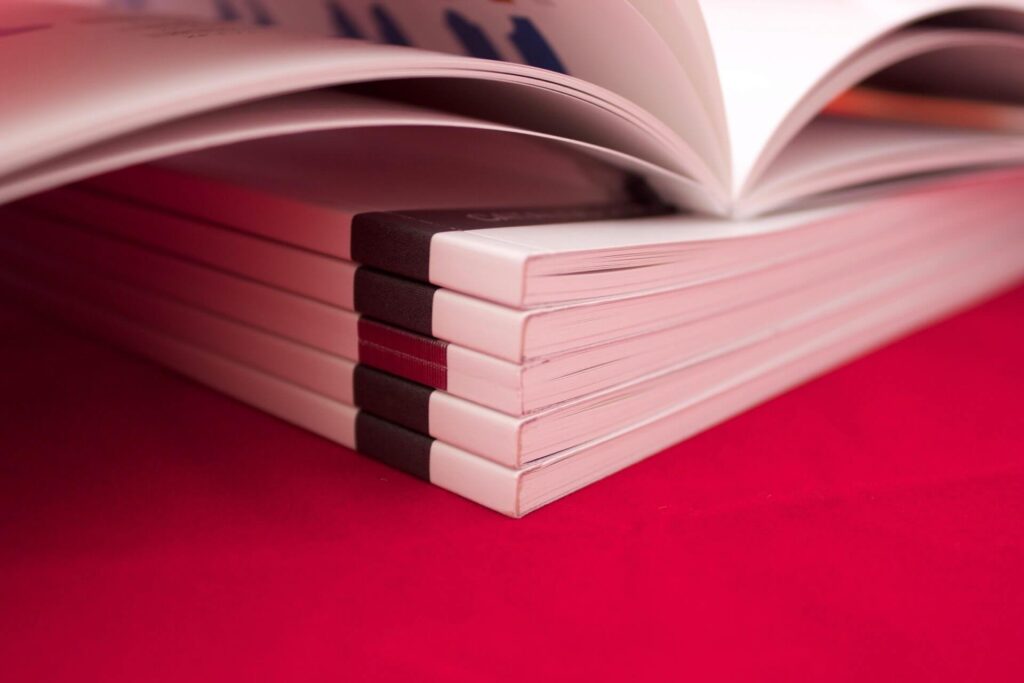
The Australian book publishing scene is a battleground between local and international contenders. Richard Celarc, CEO of Opus Group, notes that cheap imports from China pose a significant challenge. Yet, he points out the drawbacks of offshore printing, such as longer delivery times and censorship issues. This has sparked a renewed interest in people looking to Print Books Australia wide..
Macro-economic shifts and technological progress have driven book printing back to Australian shores. Despite a 0.5% annual decline in revenue over the last five years, reaching $1.9bn in 2023, the market is expected to rebound. The preference for print books is growing, especially in education where they are once again in vogue.
As the book printing scene in Australia evolves, local book printing companies are ready to capitalize. They offer affordable book printing and a variety of binding options, including bound books. From perfect binding and saddle stitching to wire binding and hardcover book printing, they aim to deliver top-notch print books. These book printing services meet the needs of authors, publishers, and businesses, ensuring Australian literature and publishing flourish.
Hardcover binding is particularly suitable for children’s books, providing a premium feel and durability. Additionally, local companies cater to niche products like graphic novels, appealing to self-publishers looking for quality printing solutions.
The State of Print Book Publishing in Australia
The Australian print book publishing sector has encountered numerous hurdles in recent times. The influx of cheap imports, especially from China, has significantly impacted the market, including the market for self published books. These imports can be produced at half the cost of local books, posing a substantial threat to domestic manufacturers like the Opus Group. The Opus Group, Australia’s largest book printer, has been particularly concerned about this trend.
The Impact of Offshore Printing and E-books
Richard Celarc, CEO of Opus Group, has highlighted the drawbacks of offshore printing. These include longer delivery times and censorship issues. The advent of e-books also presented a significant challenge, initially causing a notable decline in demand for printed books. However, the industry has seen a rebound in recent years, with a renewed interest in physical books. This resurgence is evident in both the read-for-pleasure and educational sectors, where paper-based learning is gaining traction. Additionally, the popularity of photo books has surged, reflecting a growing appreciation for high-quality, tangible products that capture intricate details and vibrant colors.
- There are printers across Australia offering book printing services, with concentrations in capitals like Sydney, Melbourne, Adelaide, and Brisbane.
- Book printers in Australia offer various printing solutions, such as offset printing, digital printing, and short-run printing.
- The quality of books printed in Australia can vary based on factors like the printing process, paper quality, and design files.
As the publishing landscape in Australia continues to evolve, local book manufacturers and retailers must adapt. They need to navigate the challenges posed by offshore printing and the increasing popularity of digital formats. At the same time, they should leverage the growing interest in physical books to stay competitive.
Print Books Australia: The Resurgence of Demand

Since 2016, the demand for printed books in Australia has seen a steady rise. Growth rates have been impressive, with 10% in the first year, 20% in the second, and 25% in the third. This surge is due to several factors, including the stabilisation of ebook demand and the return to paper-based learning by educational publishers.
Celarc, the CEO of Opus Group, notes that the read-for-pleasure market initially declined with the rise of ebooks. However, printed books have made a significant comeback. A Harvard study supports this, showing that students who used paper books scored higher than those using digital devices. This has boosted the demand for printed books in the educational sector.
High quality booklets have also played a role in the resurgence of demand for printed materials. Businesses and educational institutions are increasingly seeking professional-grade printed materials, which include both short and long runs of booklets.
Celarc also points out the timeless appeal of the “tactile pleasure” and “smell” of high-quality paper books. This sentiment is shared by the growing appreciation for the physical act of reading. This appreciation is driving the resurgence of print books in Australia.
The book printing industry in Australia is thriving, especially in book printing and print on demand (POD) book printing. These segments account for just 0.1% of all printers. The decline of the printing industry in Australia has seen a compound annual growth rate (CAGR) of 3.1% over the past five years. It is expected to reach an estimated $6.7 billion in 2024.
Despite the rise of screen-based learning and electronic education, the demand for printed books remains strong. Unit sales have increased by 2.5% from January to September compared to the previous year. This trend suggests that the “tactile pleasure” and “smell” of a high-quality book will continue to be valued by readers. This will drive the resurgence of print books in Australia.
Benefits of Printing in Australia
Printing in Australia offers numerous benefits for authors, businesses, and individuals. One of the primary advantages is the ability to work with local book printing companies that understand the unique needs of the Australian market. This allows for more personalized service, faster turnaround times, and a higher level of quality control. Additionally, printing in Australia supports the local economy and helps to create jobs.
Another benefit of printing in Australia is the ability to take advantage of the country’s high-quality printing infrastructure. Australian book printing companies have access to the latest printing technologies, including offset printing and digital printing, which enables them to produce high-quality books with vibrant colors and crisp text.
Furthermore, printing in Australia allows authors and businesses to have more control over the printing process. They can work closely with the printing company to ensure that their books are printed to their exact specifications, and they can also take advantage of services such as cover design and artwork setup. This level of involvement ensures that the final product meets their expectations and maintains a high standard of quality.
Choosing a Local Book Printing Company
When it comes to choosing a local book printing company in Australia, there are several factors to consider. One of the most important things to look for is experience. A company with a proven track record of producing high-quality books and extensive experience working with authors and businesses in your industry can be invaluable.
Another important factor to consider is the range of services offered by the printing company. Look for a company that offers a wide range of services, including perfect binding, wire binding, and hardcover book printing. This will ensure that you can get all of your printing needs met in one place, making the process more convenient and efficient.
It’s also crucial to consider the quality of the printing company’s equipment and technology. Companies that use the latest printing technologies, such as offset printing and digital printing, are more likely to produce high-quality books. This ensures that your books will have vibrant colors, crisp text, and a professional finish.
Finally, consider the level of customer service offered by the printing company. A company with a reputation for providing excellent customer service and a willingness to work closely with you to meet your printing needs can make a significant difference in the overall experience. Good customer service can help ensure that any issues are promptly addressed and that the final product meets your expectations.
Short Run Book Printing: A Game-Changer for Authors

In the rapidly changing world of book publishing, short run book printing has become a transformative solution. It benefits authors, small businesses, and educational institutions in Australia. This method offers unmatched flexibility, customization, and cost-effectiveness. It empowers creators to realize their literary dreams, whether they are producing novels, catalogs, or soft cover books with a professional finish.
The Rise of Short Run Book Printing in Australia
The growth of short run book printing in Australia is due to digital printing advancements. Unlike traditional methods, it allows for books to be printed in smaller batches. This makes it more accessible and cost-effective for self-published authors, small businesses, and educational institutions. It offers a quicker production time, the ability to update content easily, and the chance to personalize printed materials.
This flexibility is a game-changer for indie authors, enabling them to delve into niche topics while maintaining creative control. Small businesses and educational institutions also benefit, producing customized books, manuals, and other materials tailored to their needs.
- Cost-effective printing for small to medium print runs
- Faster turnaround times compared to traditional methods
- Flexibility to update and change content easily
- High-quality printing with reduced waste
- Personalization options for cover design and paper types
- Accessibility for indie authors and niche topics
With the advent of short run book printing, authors, small businesses, and educational institutions in Australia have a plethora of possibilities. Whether it’s perfect binding, saddle stitching, hardcover binding, or wire-O binding, the choices are vast. This allows creators to find the ideal solution for their unique requirements.
Binding Options for Australian Book Printers
In Australia, authors have a variety of binding options for their books. Softcover printing is cost-effective for small to medium quantities. It offers different paper types and weights, fitting the book’s purpose and budget. Perfect binding, with its strong glue spine, provides a sleek, professional look. Hard cover book printing is ideal for those seeking a durable and premium finish, with flexibility in order quantity and delivery options. Saddle stitching is a budget-friendly choice for booklets and small books.
Choosing the Right Binding Method: Perfect Binding

The choice of binding method depends on several factors. These include the number of pages, the book’s purpose, and the author’s budget. Hardcover binding offers a durable, impressive finish, ideal for premium books. Wire-O binding is versatile, suitable for manuals and calendars, allowing pages to lie flat for easy viewing. Authors should consider these factors to choose the best binding method for their needs, ensuring a high-quality final product.
- Softcover book printing: Cost-effective solution for small to medium print runs
- Perfect binding: Sleek, professional look with a strong glue spine
- Saddle stitching: Budget-friendly option for booklets and small books
- Hardcover binding: Premium, durable option for a lasting impression
- Wire-O binding: Versatile choice for manuals, calendars, and other applications
Australian book printers offer a range of binding options to authors. Whether printing a few copies or a larger run, they help bring books to life. By considering budget, page count, and purpose, authors can choose the best binding method. This ensures a high-quality final product.
Ensuring Quality: Paper and Cover Selection
When it comes to printing a book, the quality of the paper and cover is crucial. The paper used for the internal pages of the book should be of high quality and suitable for the type of book being printed. For example, if you are printing a photo book, you will want to use a high-quality paper that is designed specifically for printing photographs. This ensures that the images are vibrant and the text is clear.
The cover of the book is also an important consideration. The cover should be durable and able to withstand the wear and tear of being handled. It should also be visually appealing and reflect the content of the book. There are many different types of cover materials available, including matte and glossy finishes, and it’s important to choose the one that best suits your book.
In addition to the quality of the paper and cover, it’s also important to consider the binding method used to attach the cover to the internal pages. There are several different binding methods available, including perfect binding, wire binding, and hardcover book printing. The binding method used will depend on the type of book being printed and the desired level of durability. For instance, perfect binding offers a sleek, professional look, while wire binding is ideal for manuals and calendars that need to lie flat.
Cover Design and Artwork Setup
The cover design and artwork setup are critical components of the book printing process. The cover design should be visually appealing and reflect the content of the book. It should also be designed to grab the attention of potential readers and encourage them to buy the book. A well-designed cover can make a significant difference in the book’s marketability.
There are many different design elements that can be used to create a cover design, including images, text, and graphics. The design should be created in a format that is compatible with the printing company’s equipment, such as a PDF file. This ensures that the cover will be printed accurately and look professional.
In addition to the cover design, the artwork setup is also an important consideration. The artwork setup refers to the process of preparing the internal pages of the book for printing. This includes formatting the text and images, and ensuring that the pages are in the correct order. Proper artwork setup is essential for producing a high-quality book that meets the author’s specifications.
Customization and Print-On-Demand
One of the benefits of printing in Australia is the ability to take advantage of customization and print-on-demand services. Customization allows authors and businesses to create books that are tailored to their specific needs. This can include choosing the type of paper and cover used, as well as the binding method. Customization ensures that the final product aligns perfectly with the creator’s vision.
Print-on-demand is a service that allows books to be printed only when they are ordered. This eliminates the need for large upfront print runs and reduces the risk of unsold inventory. It also allows authors and businesses to make changes to the book as needed, without having to worry about the cost of reprinting. This flexibility is particularly beneficial for self-published authors and small businesses.
Print-on-demand is a great option for authors and businesses that want to test the market or produce small batches of books. It’s also a good option for those who want to create customized books for special occasions or events. In addition to customization and print-on-demand, many Australian book printing companies also offer a range of other services, including cover design and artwork setup, and distribution and marketing. These services can help authors and businesses to get their books into the hands of readers and to promote their work to a wider audience.
Affordable Book Printing and Flexible Book Printing Solutions
In the fast-paced world of Australian publishing, authors and businesses are embracing short run book printing. This method not only cuts costs but also brings unmatched flexibility. It’s a breakthrough for creators nationwide.
Short run book printing lets businesses and authors print just what they need. This avoids the hefty costs of bulk printing. It also supports quick updates and changes, reducing waste and making inventory management smoother. This boosts its cost-effectiveness even more.
MVP Print, a top name in Australian book printing, has over 15 years of self-publishing experience. They provide tailored quotes and use cutting-edge printing technologies like inkjet, dry toner, and offset printing. This ensures high-quality results at competitive prices for short run book printing.
This innovative method makes it easier for Australian creators to bring their projects to life affordably. Cost-effective and flexible book printing is now more accessible than ever. It’s a sustainable and efficient solution for authors, small businesses, and startups alike, meeting their publishing needs.
Conclusion
In our journey through the Australian print book industry, we’ve highlighted the crucial role of offshore printing and the growing interest in locally-printed books. The advent of short run book printing has been transformative. It provides authors, small enterprises, and educational bodies with an economical, adaptable, and customised method for book creation.
The variety of binding options for short run books has broadened, from softcover to hardcover. This diversity, combined with MVP Print’s competitive pricing and swift service, has made short run printing a compelling choice. It’s ideal for those wanting to bring their stories to life.
As the print book market in Australia expands, and short run printing technology advances, local book printing’s importance will only grow. By leveraging the advantages of custom and agile book production, creators can tap into the renewed interest in physical books. They can deliver premium, bespoke products to their audience.








